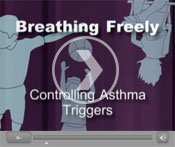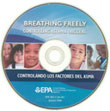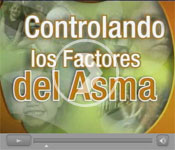Publications and Resources
Additional Indoor Air Quality resources on Secondhand Smoke, IAQ Tools for Schools, Radon, Mold, Large Buildings and Homes can be accessed through our Indoor Air Publications site or accessed directly through any of the other IAQ topics hyper-linked above.
Get the Adobe Acrobat Reader to view PDF files linked on this page. See EPA's PDF page to learn more. [Formato de Documento Portable]

Most of these resources can be downloaded as PDF files. See "How to Order" for information on how to obtain hard copy of these free resources. Use the publication number (in bold) when ordering.
- Asthma Home Environment Checklist
- Breathing Freely: Controlling Asthma Triggers/Controlando los Factores del Asma Video
- Clear Your Home of Asthma Triggers: Your Children Will Breathe Easier
- Clearing the Air: Asthma and Indoor Air Exposures - NAS Report
- Dusty The Asthma Goldfish and His Asthma Triggers Funbook / Dusty La Carpa Dorada del Asma y Sus Provocadores de Asma
- Health at Home: Controlling Asthma Triggers Video
- Help Your Child Gain Control Over Asthma
- Implementing An Asthma Home Visit Program: 10 Steps To Help Health Plans Get Started
- Managing Asthma in the School Environment
- Working Together: So Everyone Can Breathe Better Brochure
-
Asthma Awareness Month Event Planning Kit
How to Order
Web-only Resources
- Asthma Bulletins/Newsletters
- Asthma Fact Sheet / Datos sobre el asma
- Clearing the Air: 10 Steps to Making Your Home Asthma-Friendly / Cómo purificar el aire que provoca ataques de asma en interiores
- In-Home Environmental Education Program, Case Study: Children's Hospital of Philadelphia
- NAS Report - Clearing the Air: Asthma and Indoor Air Exposure
- Health at Home: Controlling Asthma Triggers Video
| Asthma Home Environment Checklist | |
 |
EPA developed the
Home Environment Checklist to help home care visitors by providing a list of questions and action steps to assist in the identification and mitigation of environmental asthma triggers commonly found in and around homes. The checklist is designed to allow home care visitors to focus on the specific activities or things in a room - in particular the asthma patient’s sleeping area - that might produce or harbor environmental triggers. The activities recommended in the checklist are generally simple and low cost.
|
| Breathing Freely: Controlling Asthma Triggers Video | |
 |

|
| Controlando los Factores del Asma Video | |

|
|
 |
Clear Your Home of Asthma Triggers: Your Children Will Breathe Easier
This tri-fold brochure is a handy resource for parents and caretakers of children with asthma. It discusses five common environmental triggers and ways to reduce exposures to these triggers indoors. Parents can follow the step-by-step guidance to reduce asthma triggers in their homes and minimize their children's exposure to triggers that may increase the number or severity of their asthma attacks.
Also, available for order and download as PDF files: Spanish (PDF, 2 pp, 245KB) [EPA 402-F-99-005D]; Chinese (PDF, 2 pp, 348KB) [EPA 402-F-99-005A September 1999]; Korean (PDF, 2 pp, 426KB) [EPA 402-F-99-005C September 1999] and, Vietnamese (PDF, 2 pp, 320KB) [EPA 402-F-99-005B September 1999] |
| Dusty The Asthma Goldfish and His Asthma Triggers Funbook | |
 |
Check out EPA's educational tool to help parents and children learn more about asthma triggers.

|
| Help Your Child Gain Control Over Asthma | |
  |
Help Your Child Gain Control Over Asthma, a low-literacy asthma management guide. The brochure provides parents of children with asthma with the information they need to improve their children's quality of life. It is filled with tips on managing asthma by developing a management plan and following some simple steps to minimize exposure to asthma triggers found indoors and out. The brochure includes helpful visuals that display how to implement the suggested steps.
Ayude a su niño a controlar el asma
|
| Implementing An Asthma Home Visit Program: 10 Steps To Help Health Plans Get Started | |
 |
As part of a comprehensive asthma management program, home visits can provide people with asthma an extra level of support and can contribute to the success and sustainability of a health plan’s asthma disease management program. EPA's new guide, Implementing An Asthma Home Visit Program: 10 Steps To Help Health Plans Get Started, offers step-by-step instructions on how to start an asthma home visit program with a particular emphasis on environmental risk factor management.
|
| Managing Asthma in the School Environment | |
 |
This guide offers valuable information for all school staff, especially school nurses, teachers, and maintenance staff, on how to identify and control common environmental factors in schools that trigger asthma attacks. Resources include an "Asthma Action Card" which can serve as a daily asthma management plan. School nurses can share these resources with parents to raise awareness of asthma triggers and to help manage asthma at home and school effectively. Also included are easy tips for managing asthma in schools, including using the IAQ TfS Kit and Program to improve IAQ in the learning environment.
|
| Working Together: So Everyone Can Breathe Better Brochure | |
 |
EPA's brochure describes the Asthma Program's goals, methods and mission. The tri-fold brochure includes information on EPA's Media Campaign,
community-based outreach and national partners and efforts to support scientific research on asthma and asthma management. Learn more about EPA's
Asthma Program by ordering copies of the brochure.
|
You can order Indoor Air Quality publications from EPA's National Service Center for Environmental Publications (NSCEP):
U.S. Environmental Protection Agency
National Service Center for Environmental Publications (NSCEP)
P.O. Box 42419
Cincinnati, OH 45242-0419
Website: www.epa.gov/nscep
Phone: 1-800-490-9198
Fax: (301) 604-3408
E-mail: nscep@bps-lmit.comNSCEP operates a Toll-free phone service for EPA Publication Assistance with live customer service representative assistance Monday through Friday from 9:00am-5:30pm eastern time. Voice Mail is available after operating hours. You can fax or e-mail your publication requests. For technical assistance with NSCEP web pages, write to: nscep_nepis.tech@epa.gov
Please use the EPA Document Number, which is usually bolded or highlighted, when ordering from NSCEP.
How Do I Order Other EPA Publications? Click Here
 |
Asthma Bulletins
Asthma Bulletin #1 highlights outreach and education efforts related to EPA's Asthma Initiative. You will read about partnerships, World Asthma Day activities, a successful media campaign and much more.
Asthma Bulletin #2 provides information highlighting our program activities and resources designed for health care providers.
|
 |
Asthma Fact Sheet
The Asthma Fact Sheet highlights the most up-to-date asthma statistics. |
 |
Clearing the Air: 10 Steps to Making Your Home Asthma-Friendly
This one-page, step-by-step guidance provides helpful hints for comprehensive asthma management.
Cómo purificar el aire que provoca ataques de asma en interiores: Diez pasos para hacer su casa acogedora para asmáticos
|
 |
In-Home Environmental Education Program, Case Study: Children's Hospital of
Philadelphia The Children's Hospital of Philadelphia case study is intended to offer providers, health insurers, public health departments and community-based organizations an overview of an asthma in-home intervention.
|
 |
National Academy of Sciences Report - Clearing the Air: Asthma and Indoor Air Exposures EPA asked the National Academy of Sciences (NAS) to assess the role of indoor air quality in the growing asthma problem. EPA asked NAS to characterize the state of the science on health impacts and prevention strategies, and to provide recommendations on needed research. In response, the National Academy of Sciences Institute of Medicine issued a report, Clearing the Air: Asthma and Indoor Air Exposures, on the role of indoor environmental pollutants in the development and exacerbation of asthma. The report affirms the Administrator's asthma initiative to educate the public about the ways they can help control asthma by managing indoor air quality. The report concludes that exposure to indoor pollutants is an important contributor to the asthma problem in this nation. Asthma sufferers should consult with their doctor about reducing their exposure to secondhand smoke, dust mites, pet dander, molds and cockroaches.
|
 |
Health at Home: Controlling Asthma Triggers Video
This video was developed by the American Lung Association of Eastern Missouri with funds from the EPA. It provides an overview of what current research shows to be the most effective methods of reducing levels of secondhand smoke and allergens from dust mites, cockroaches, molds and pets in your home. Studies have shown that many people with asthma are sensitive to these substances and health improvements may result from their effective control in the home.
|
![[logo] US EPA](https://webarchive.library.unt.edu/eot2008/20090508175352im_/http://www.epa.gov/epafiles/images/logo_epaseal.gif)
